Project Dissertation: Media Representation and the Impact of Terrorism
VerifiedAdded on 2023/06/09
|74
|23522
|393
Project
AI Summary
This project dissertation investigates how media represents terrorism, focusing on media's role, potential biases, and the spread of Islamophobia. The research employs qualitative methods to analyze news trends in major Western media outlets. The study examines the relationship between media and terrorism, highlighting how media coverage can influence public perception and political decisions. It explores whether media coverage is biased towards certain groups, particularly Muslims, and whether this contributes to Islamophobia. The findings suggest that Western media often exhibits a biased perception of terrorism, potentially leading to social fragmentation and overlooking the root causes of terrorist activities. The research concludes by emphasizing the need for a broader representation of global terrorism, including coverage of events in the Middle East and Africa. Desklib provides students access to this and many other solved assignments.
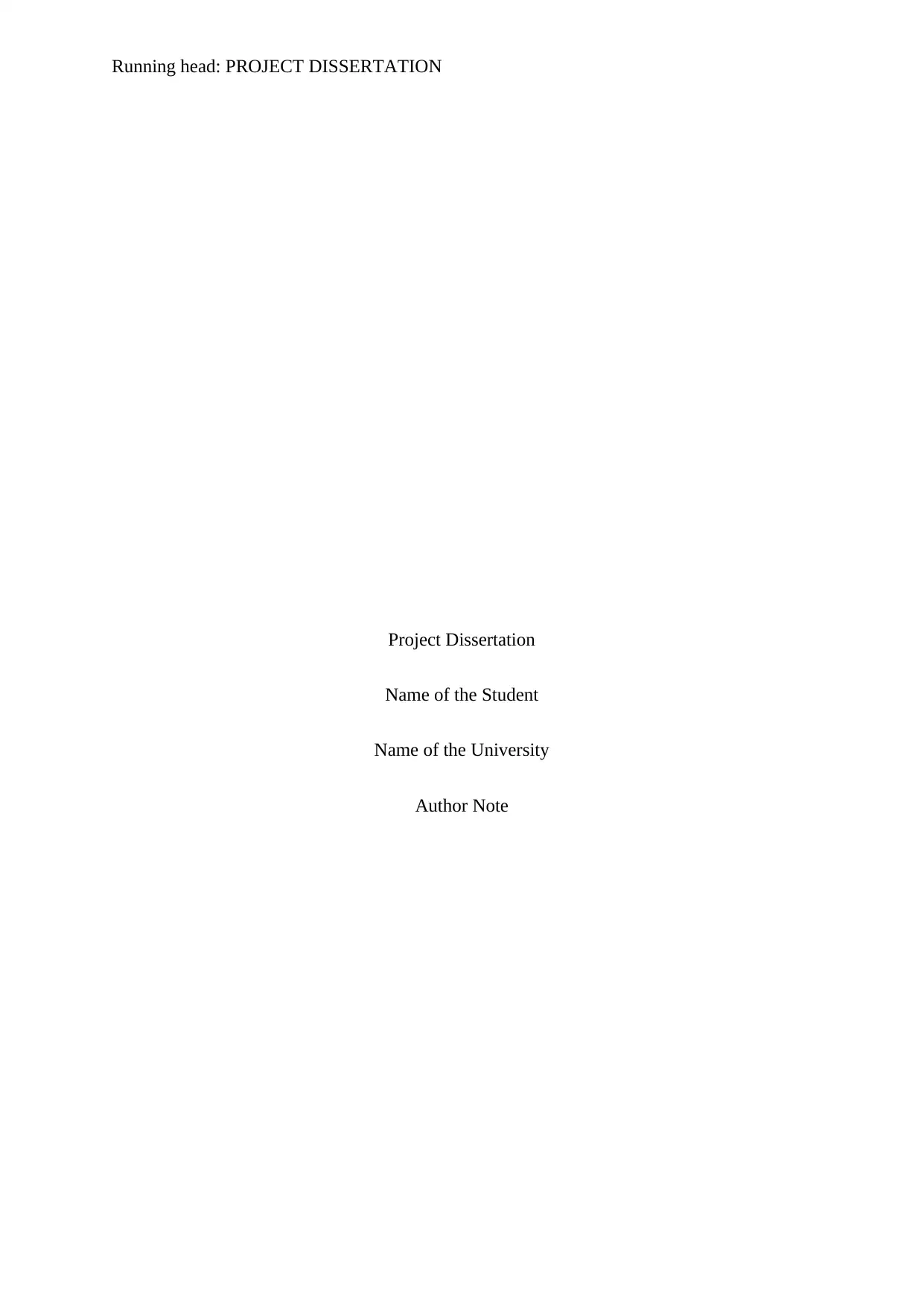
Running head: PROJECT DISSERTATION
Project Dissertation
Name of the Student
Name of the University
Author Note
Project Dissertation
Name of the Student
Name of the University
Author Note
Paraphrase This Document
Need a fresh take? Get an instant paraphrase of this document with our AI Paraphraser
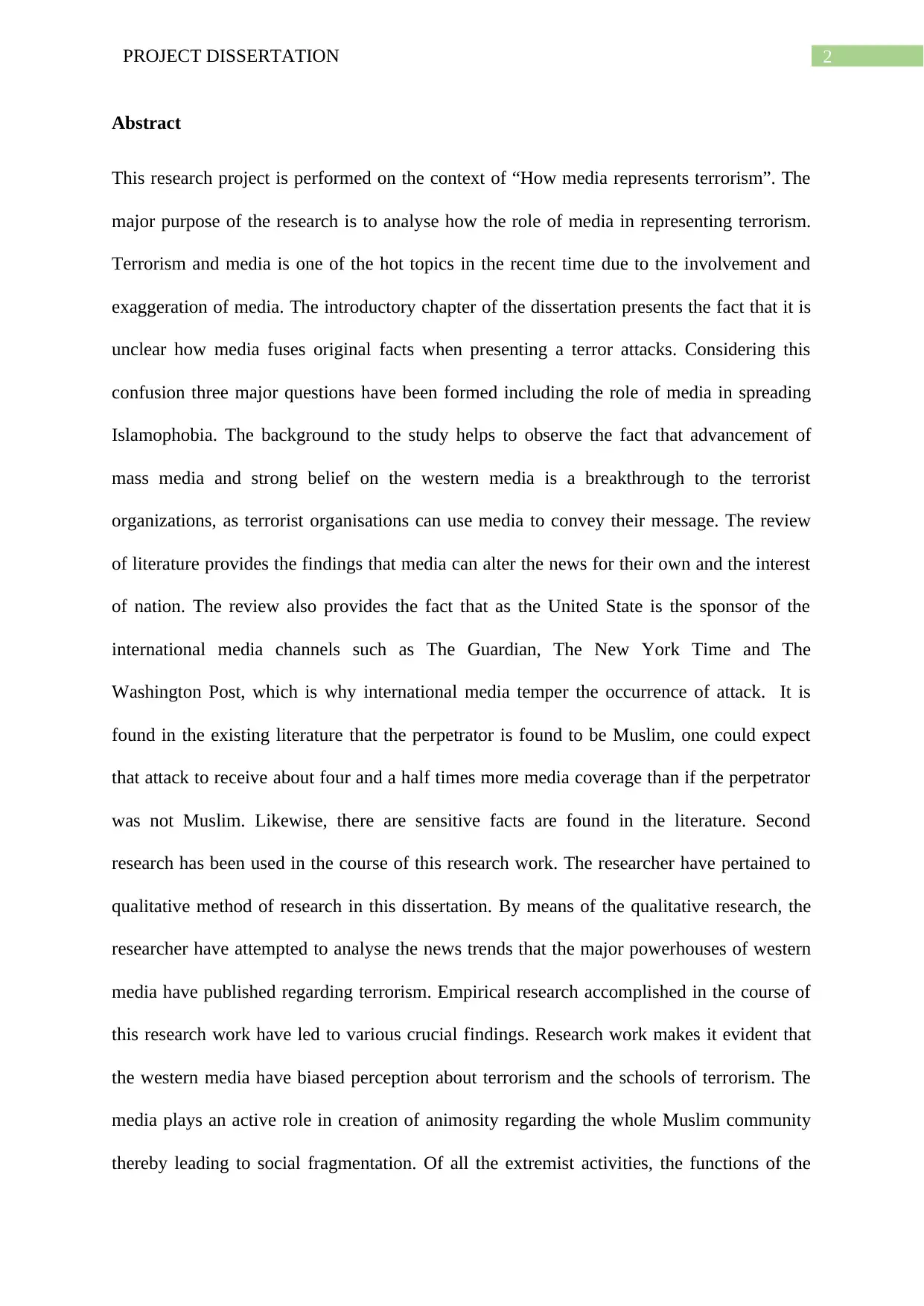
2PROJECT DISSERTATION
Abstract
This research project is performed on the context of “How media represents terrorism”. The
major purpose of the research is to analyse how the role of media in representing terrorism.
Terrorism and media is one of the hot topics in the recent time due to the involvement and
exaggeration of media. The introductory chapter of the dissertation presents the fact that it is
unclear how media fuses original facts when presenting a terror attacks. Considering this
confusion three major questions have been formed including the role of media in spreading
Islamophobia. The background to the study helps to observe the fact that advancement of
mass media and strong belief on the western media is a breakthrough to the terrorist
organizations, as terrorist organisations can use media to convey their message. The review
of literature provides the findings that media can alter the news for their own and the interest
of nation. The review also provides the fact that as the United State is the sponsor of the
international media channels such as The Guardian, The New York Time and The
Washington Post, which is why international media temper the occurrence of attack. It is
found in the existing literature that the perpetrator is found to be Muslim, one could expect
that attack to receive about four and a half times more media coverage than if the perpetrator
was not Muslim. Likewise, there are sensitive facts are found in the literature. Second
research has been used in the course of this research work. The researcher have pertained to
qualitative method of research in this dissertation. By means of the qualitative research, the
researcher have attempted to analyse the news trends that the major powerhouses of western
media have published regarding terrorism. Empirical research accomplished in the course of
this research work have led to various crucial findings. Research work makes it evident that
the western media have biased perception about terrorism and the schools of terrorism. The
media plays an active role in creation of animosity regarding the whole Muslim community
thereby leading to social fragmentation. Of all the extremist activities, the functions of the
Abstract
This research project is performed on the context of “How media represents terrorism”. The
major purpose of the research is to analyse how the role of media in representing terrorism.
Terrorism and media is one of the hot topics in the recent time due to the involvement and
exaggeration of media. The introductory chapter of the dissertation presents the fact that it is
unclear how media fuses original facts when presenting a terror attacks. Considering this
confusion three major questions have been formed including the role of media in spreading
Islamophobia. The background to the study helps to observe the fact that advancement of
mass media and strong belief on the western media is a breakthrough to the terrorist
organizations, as terrorist organisations can use media to convey their message. The review
of literature provides the findings that media can alter the news for their own and the interest
of nation. The review also provides the fact that as the United State is the sponsor of the
international media channels such as The Guardian, The New York Time and The
Washington Post, which is why international media temper the occurrence of attack. It is
found in the existing literature that the perpetrator is found to be Muslim, one could expect
that attack to receive about four and a half times more media coverage than if the perpetrator
was not Muslim. Likewise, there are sensitive facts are found in the literature. Second
research has been used in the course of this research work. The researcher have pertained to
qualitative method of research in this dissertation. By means of the qualitative research, the
researcher have attempted to analyse the news trends that the major powerhouses of western
media have published regarding terrorism. Empirical research accomplished in the course of
this research work have led to various crucial findings. Research work makes it evident that
the western media have biased perception about terrorism and the schools of terrorism. The
media plays an active role in creation of animosity regarding the whole Muslim community
thereby leading to social fragmentation. Of all the extremist activities, the functions of the
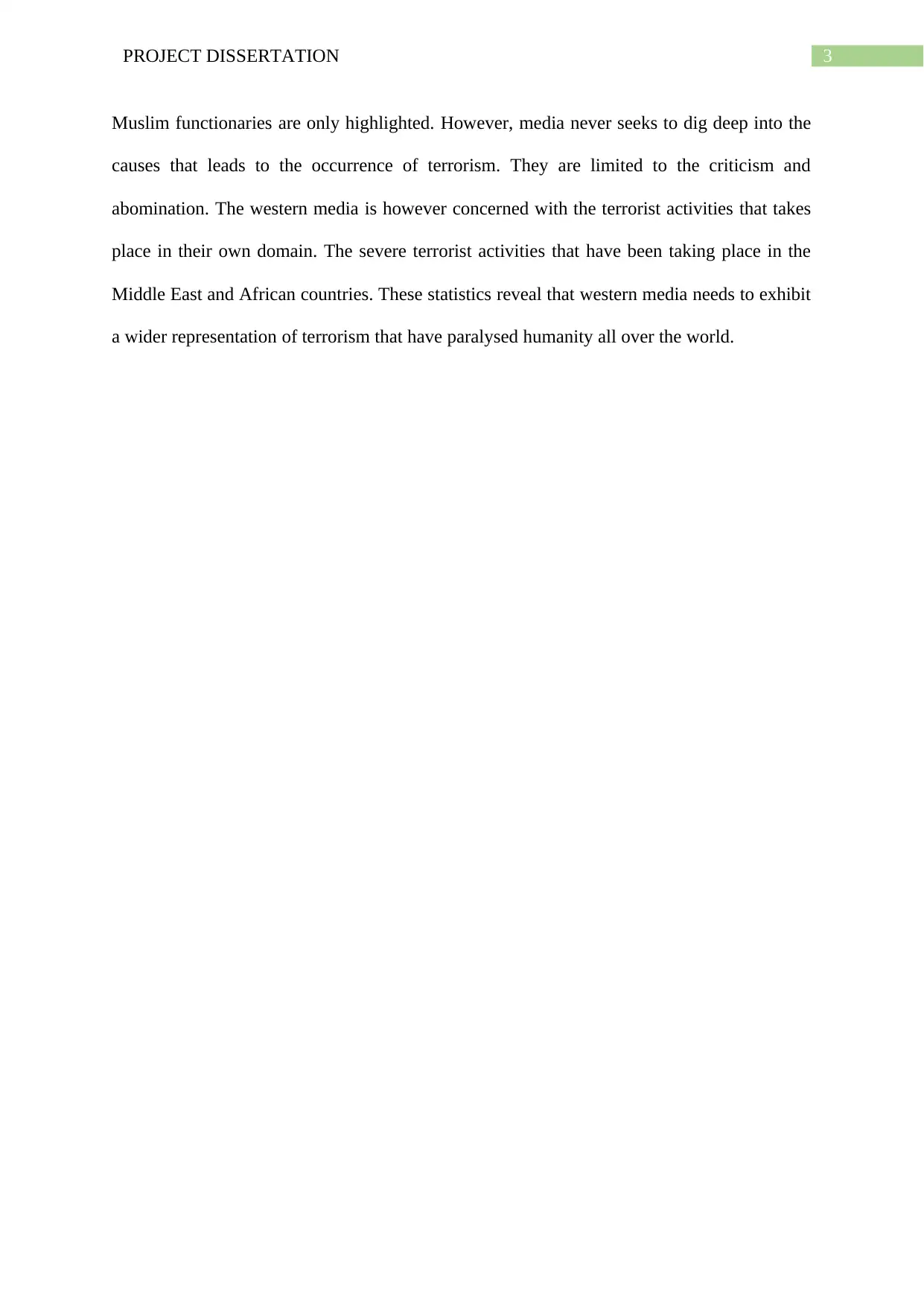
3PROJECT DISSERTATION
Muslim functionaries are only highlighted. However, media never seeks to dig deep into the
causes that leads to the occurrence of terrorism. They are limited to the criticism and
abomination. The western media is however concerned with the terrorist activities that takes
place in their own domain. The severe terrorist activities that have been taking place in the
Middle East and African countries. These statistics reveal that western media needs to exhibit
a wider representation of terrorism that have paralysed humanity all over the world.
Muslim functionaries are only highlighted. However, media never seeks to dig deep into the
causes that leads to the occurrence of terrorism. They are limited to the criticism and
abomination. The western media is however concerned with the terrorist activities that takes
place in their own domain. The severe terrorist activities that have been taking place in the
Middle East and African countries. These statistics reveal that western media needs to exhibit
a wider representation of terrorism that have paralysed humanity all over the world.
⊘ This is a preview!⊘
Do you want full access?
Subscribe today to unlock all pages.

Trusted by 1+ million students worldwide
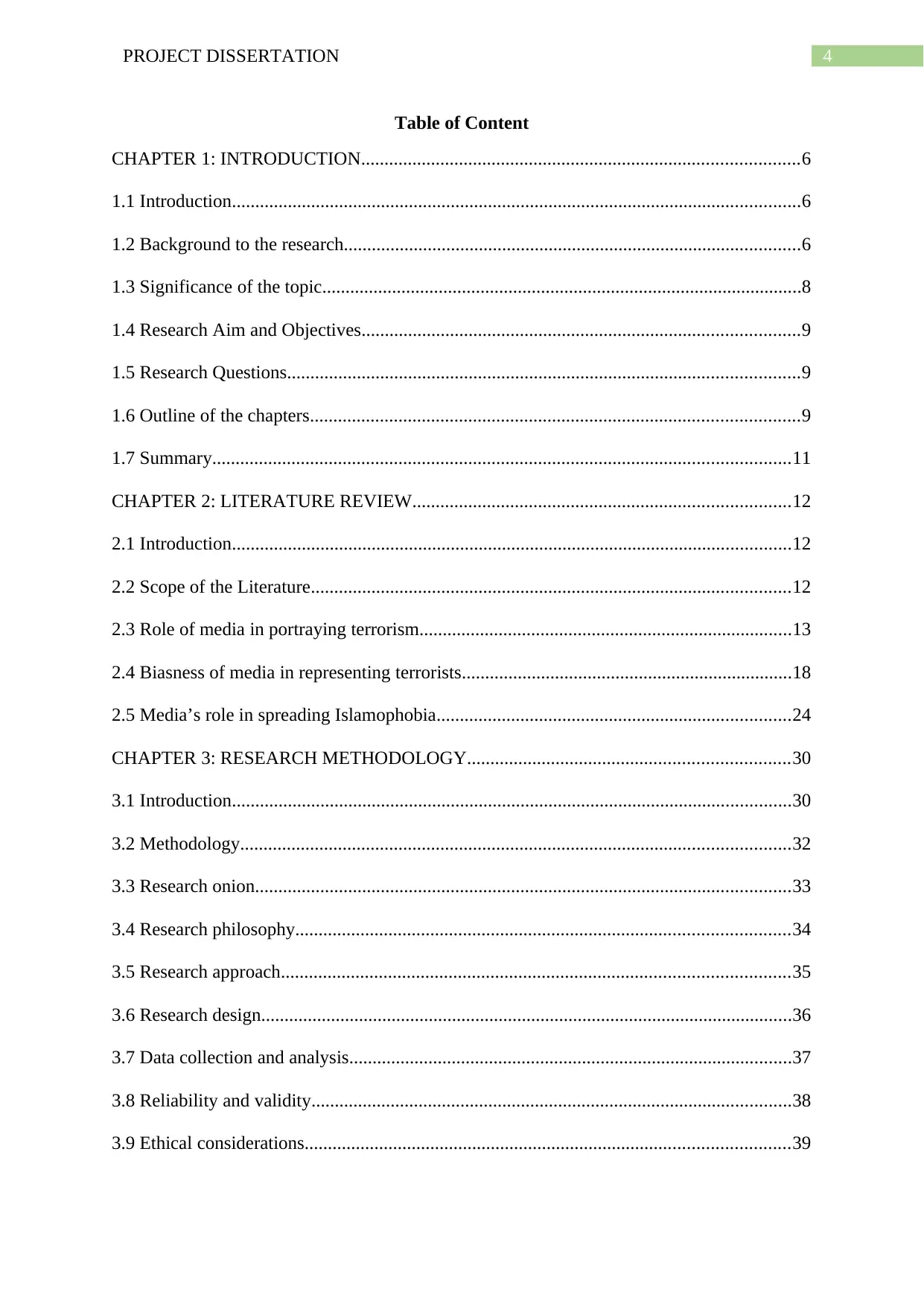
4PROJECT DISSERTATION
Table of Content
CHAPTER 1: INTRODUCTION..............................................................................................6
1.1 Introduction..........................................................................................................................6
1.2 Background to the research..................................................................................................6
1.3 Significance of the topic.......................................................................................................8
1.4 Research Aim and Objectives..............................................................................................9
1.5 Research Questions..............................................................................................................9
1.6 Outline of the chapters.........................................................................................................9
1.7 Summary............................................................................................................................11
CHAPTER 2: LITERATURE REVIEW.................................................................................12
2.1 Introduction........................................................................................................................12
2.2 Scope of the Literature.......................................................................................................12
2.3 Role of media in portraying terrorism................................................................................13
2.4 Biasness of media in representing terrorists.......................................................................18
2.5 Media’s role in spreading Islamophobia............................................................................24
CHAPTER 3: RESEARCH METHODOLOGY.....................................................................30
3.1 Introduction........................................................................................................................30
3.2 Methodology......................................................................................................................32
3.3 Research onion...................................................................................................................33
3.4 Research philosophy..........................................................................................................34
3.5 Research approach.............................................................................................................35
3.6 Research design..................................................................................................................36
3.7 Data collection and analysis...............................................................................................37
3.8 Reliability and validity.......................................................................................................38
3.9 Ethical considerations........................................................................................................39
Table of Content
CHAPTER 1: INTRODUCTION..............................................................................................6
1.1 Introduction..........................................................................................................................6
1.2 Background to the research..................................................................................................6
1.3 Significance of the topic.......................................................................................................8
1.4 Research Aim and Objectives..............................................................................................9
1.5 Research Questions..............................................................................................................9
1.6 Outline of the chapters.........................................................................................................9
1.7 Summary............................................................................................................................11
CHAPTER 2: LITERATURE REVIEW.................................................................................12
2.1 Introduction........................................................................................................................12
2.2 Scope of the Literature.......................................................................................................12
2.3 Role of media in portraying terrorism................................................................................13
2.4 Biasness of media in representing terrorists.......................................................................18
2.5 Media’s role in spreading Islamophobia............................................................................24
CHAPTER 3: RESEARCH METHODOLOGY.....................................................................30
3.1 Introduction........................................................................................................................30
3.2 Methodology......................................................................................................................32
3.3 Research onion...................................................................................................................33
3.4 Research philosophy..........................................................................................................34
3.5 Research approach.............................................................................................................35
3.6 Research design..................................................................................................................36
3.7 Data collection and analysis...............................................................................................37
3.8 Reliability and validity.......................................................................................................38
3.9 Ethical considerations........................................................................................................39
Paraphrase This Document
Need a fresh take? Get an instant paraphrase of this document with our AI Paraphraser
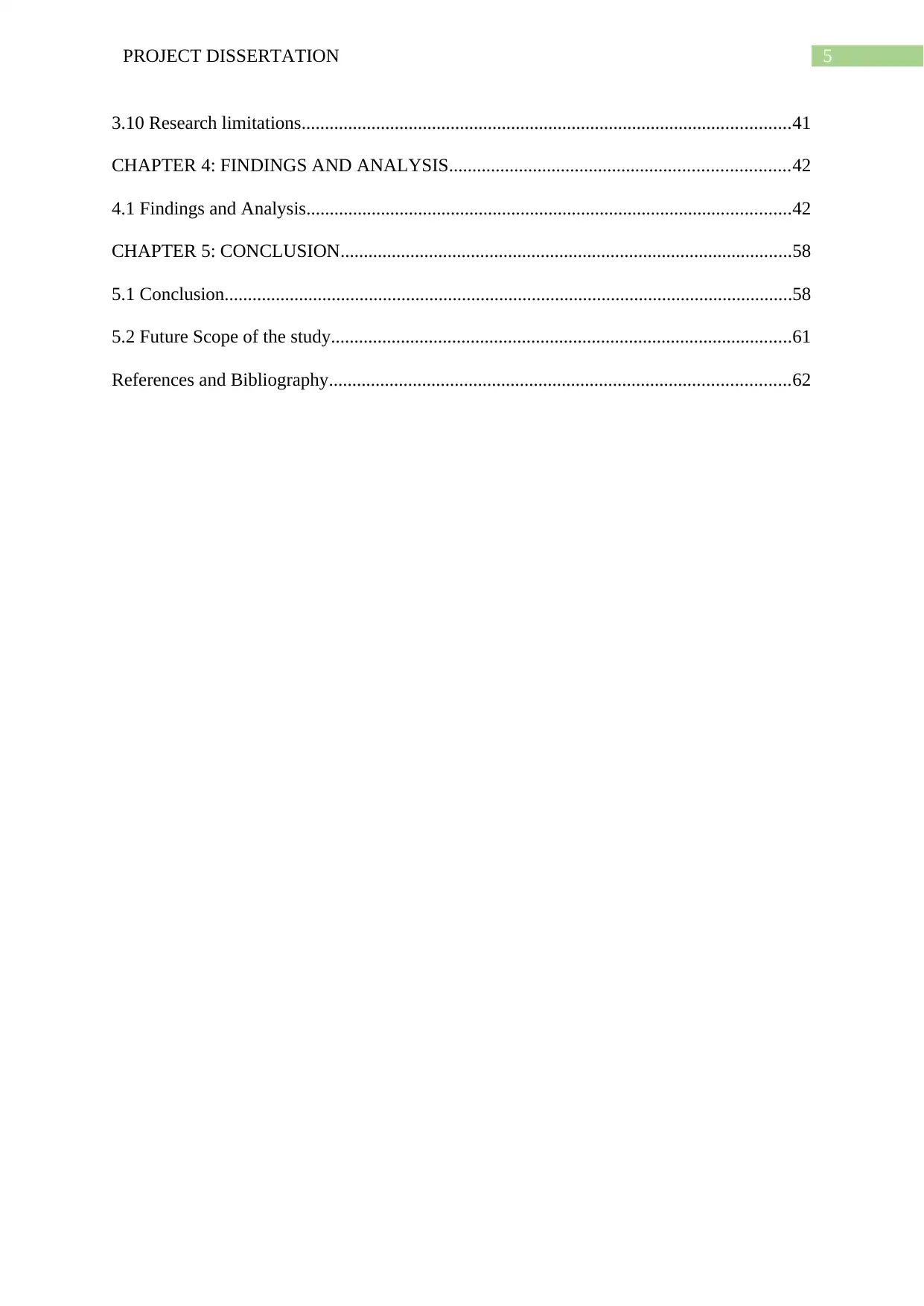
5PROJECT DISSERTATION
3.10 Research limitations.........................................................................................................41
CHAPTER 4: FINDINGS AND ANALYSIS.........................................................................42
4.1 Findings and Analysis........................................................................................................42
CHAPTER 5: CONCLUSION.................................................................................................58
5.1 Conclusion..........................................................................................................................58
5.2 Future Scope of the study...................................................................................................61
References and Bibliography...................................................................................................62
3.10 Research limitations.........................................................................................................41
CHAPTER 4: FINDINGS AND ANALYSIS.........................................................................42
4.1 Findings and Analysis........................................................................................................42
CHAPTER 5: CONCLUSION.................................................................................................58
5.1 Conclusion..........................................................................................................................58
5.2 Future Scope of the study...................................................................................................61
References and Bibliography...................................................................................................62
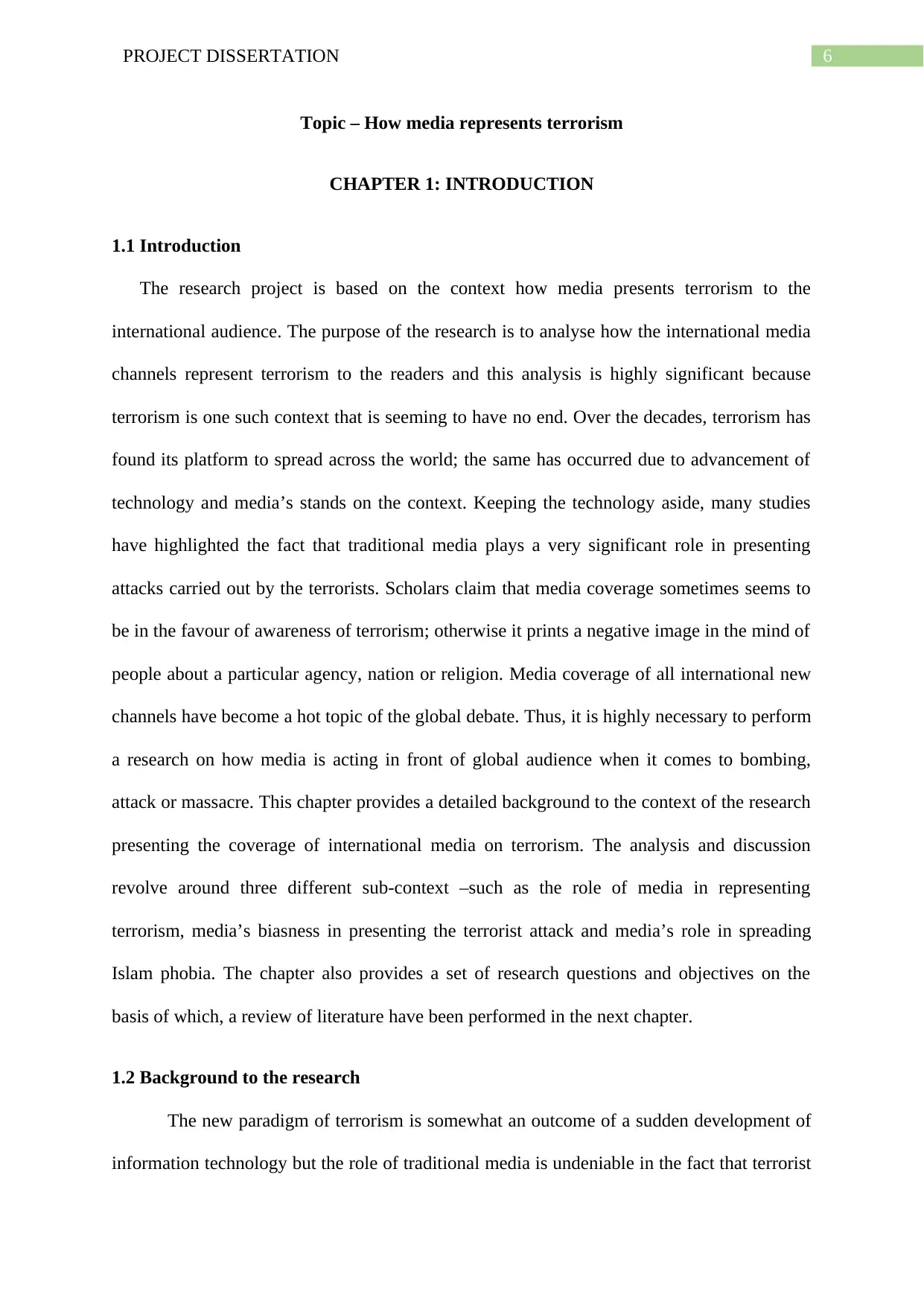
6PROJECT DISSERTATION
Topic – How media represents terrorism
CHAPTER 1: INTRODUCTION
1.1 Introduction
The research project is based on the context how media presents terrorism to the
international audience. The purpose of the research is to analyse how the international media
channels represent terrorism to the readers and this analysis is highly significant because
terrorism is one such context that is seeming to have no end. Over the decades, terrorism has
found its platform to spread across the world; the same has occurred due to advancement of
technology and media’s stands on the context. Keeping the technology aside, many studies
have highlighted the fact that traditional media plays a very significant role in presenting
attacks carried out by the terrorists. Scholars claim that media coverage sometimes seems to
be in the favour of awareness of terrorism; otherwise it prints a negative image in the mind of
people about a particular agency, nation or religion. Media coverage of all international new
channels have become a hot topic of the global debate. Thus, it is highly necessary to perform
a research on how media is acting in front of global audience when it comes to bombing,
attack or massacre. This chapter provides a detailed background to the context of the research
presenting the coverage of international media on terrorism. The analysis and discussion
revolve around three different sub-context –such as the role of media in representing
terrorism, media’s biasness in presenting the terrorist attack and media’s role in spreading
Islam phobia. The chapter also provides a set of research questions and objectives on the
basis of which, a review of literature have been performed in the next chapter.
1.2 Background to the research
The new paradigm of terrorism is somewhat an outcome of a sudden development of
information technology but the role of traditional media is undeniable in the fact that terrorist
Topic – How media represents terrorism
CHAPTER 1: INTRODUCTION
1.1 Introduction
The research project is based on the context how media presents terrorism to the
international audience. The purpose of the research is to analyse how the international media
channels represent terrorism to the readers and this analysis is highly significant because
terrorism is one such context that is seeming to have no end. Over the decades, terrorism has
found its platform to spread across the world; the same has occurred due to advancement of
technology and media’s stands on the context. Keeping the technology aside, many studies
have highlighted the fact that traditional media plays a very significant role in presenting
attacks carried out by the terrorists. Scholars claim that media coverage sometimes seems to
be in the favour of awareness of terrorism; otherwise it prints a negative image in the mind of
people about a particular agency, nation or religion. Media coverage of all international new
channels have become a hot topic of the global debate. Thus, it is highly necessary to perform
a research on how media is acting in front of global audience when it comes to bombing,
attack or massacre. This chapter provides a detailed background to the context of the research
presenting the coverage of international media on terrorism. The analysis and discussion
revolve around three different sub-context –such as the role of media in representing
terrorism, media’s biasness in presenting the terrorist attack and media’s role in spreading
Islam phobia. The chapter also provides a set of research questions and objectives on the
basis of which, a review of literature have been performed in the next chapter.
1.2 Background to the research
The new paradigm of terrorism is somewhat an outcome of a sudden development of
information technology but the role of traditional media is undeniable in the fact that terrorist
⊘ This is a preview!⊘
Do you want full access?
Subscribe today to unlock all pages.

Trusted by 1+ million students worldwide
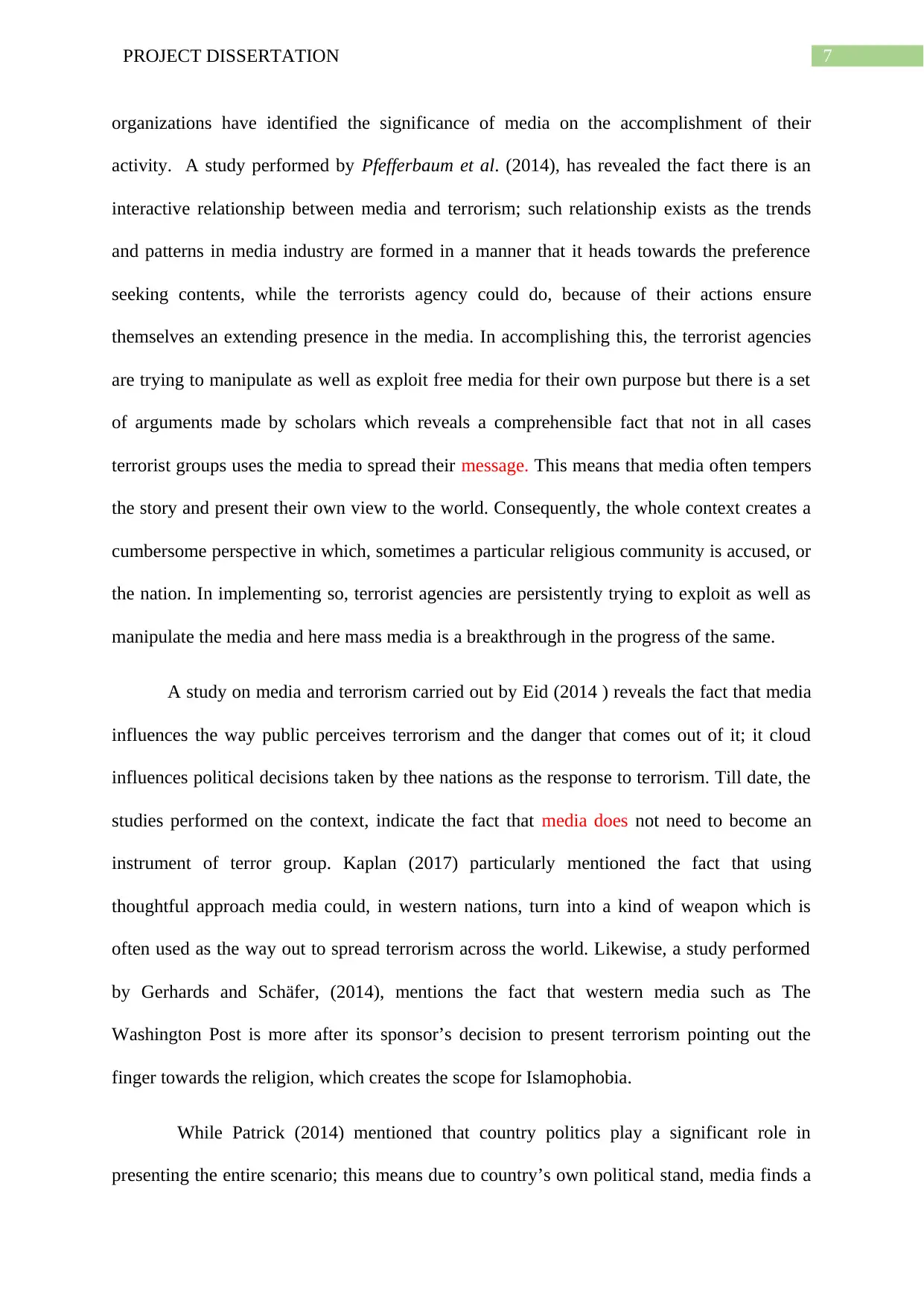
7PROJECT DISSERTATION
organizations have identified the significance of media on the accomplishment of their
activity. A study performed by Pfefferbaum et al. (2014), has revealed the fact there is an
interactive relationship between media and terrorism; such relationship exists as the trends
and patterns in media industry are formed in a manner that it heads towards the preference
seeking contents, while the terrorists agency could do, because of their actions ensure
themselves an extending presence in the media. In accomplishing this, the terrorist agencies
are trying to manipulate as well as exploit free media for their own purpose but there is a set
of arguments made by scholars which reveals a comprehensible fact that not in all cases
terrorist groups uses the media to spread their message. This means that media often tempers
the story and present their own view to the world. Consequently, the whole context creates a
cumbersome perspective in which, sometimes a particular religious community is accused, or
the nation. In implementing so, terrorist agencies are persistently trying to exploit as well as
manipulate the media and here mass media is a breakthrough in the progress of the same.
A study on media and terrorism carried out by Eid (2014 ) reveals the fact that media
influences the way public perceives terrorism and the danger that comes out of it; it cloud
influences political decisions taken by thee nations as the response to terrorism. Till date, the
studies performed on the context, indicate the fact that media does not need to become an
instrument of terror group. Kaplan (2017) particularly mentioned the fact that using
thoughtful approach media could, in western nations, turn into a kind of weapon which is
often used as the way out to spread terrorism across the world. Likewise, a study performed
by Gerhards and Schäfer, (2014), mentions the fact that western media such as The
Washington Post is more after its sponsor’s decision to present terrorism pointing out the
finger towards the religion, which creates the scope for Islamophobia.
While Patrick (2014) mentioned that country politics play a significant role in
presenting the entire scenario; this means due to country’s own political stand, media finds a
organizations have identified the significance of media on the accomplishment of their
activity. A study performed by Pfefferbaum et al. (2014), has revealed the fact there is an
interactive relationship between media and terrorism; such relationship exists as the trends
and patterns in media industry are formed in a manner that it heads towards the preference
seeking contents, while the terrorists agency could do, because of their actions ensure
themselves an extending presence in the media. In accomplishing this, the terrorist agencies
are trying to manipulate as well as exploit free media for their own purpose but there is a set
of arguments made by scholars which reveals a comprehensible fact that not in all cases
terrorist groups uses the media to spread their message. This means that media often tempers
the story and present their own view to the world. Consequently, the whole context creates a
cumbersome perspective in which, sometimes a particular religious community is accused, or
the nation. In implementing so, terrorist agencies are persistently trying to exploit as well as
manipulate the media and here mass media is a breakthrough in the progress of the same.
A study on media and terrorism carried out by Eid (2014 ) reveals the fact that media
influences the way public perceives terrorism and the danger that comes out of it; it cloud
influences political decisions taken by thee nations as the response to terrorism. Till date, the
studies performed on the context, indicate the fact that media does not need to become an
instrument of terror group. Kaplan (2017) particularly mentioned the fact that using
thoughtful approach media could, in western nations, turn into a kind of weapon which is
often used as the way out to spread terrorism across the world. Likewise, a study performed
by Gerhards and Schäfer, (2014), mentions the fact that western media such as The
Washington Post is more after its sponsor’s decision to present terrorism pointing out the
finger towards the religion, which creates the scope for Islamophobia.
While Patrick (2014) mentioned that country politics play a significant role in
presenting the entire scenario; this means due to country’s own political stand, media finds a
Paraphrase This Document
Need a fresh take? Get an instant paraphrase of this document with our AI Paraphraser
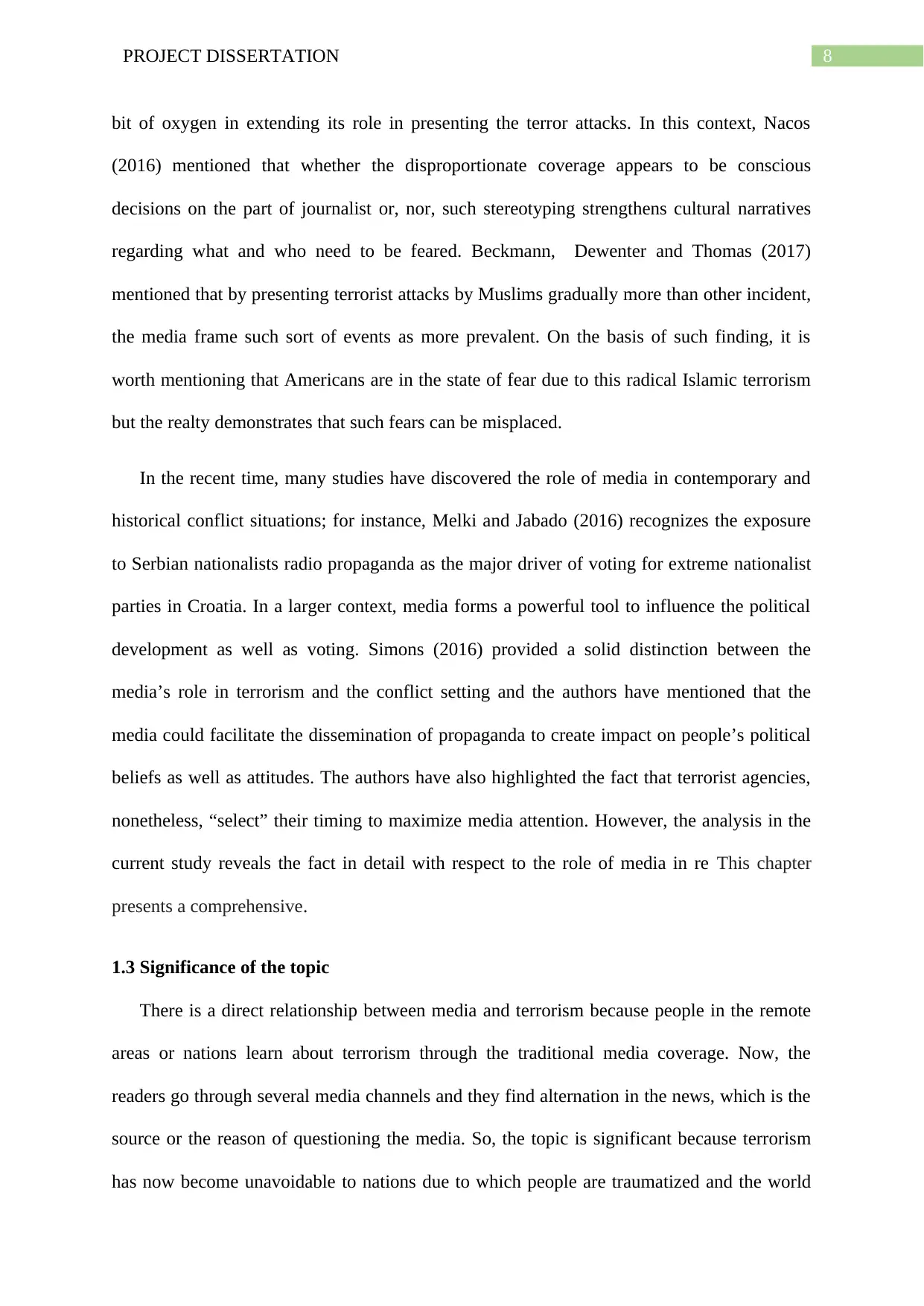
8PROJECT DISSERTATION
bit of oxygen in extending its role in presenting the terror attacks. In this context, Nacos
(2016) mentioned that whether the disproportionate coverage appears to be conscious
decisions on the part of journalist or, nor, such stereotyping strengthens cultural narratives
regarding what and who need to be feared. Beckmann, Dewenter and Thomas (2017)
mentioned that by presenting terrorist attacks by Muslims gradually more than other incident,
the media frame such sort of events as more prevalent. On the basis of such finding, it is
worth mentioning that Americans are in the state of fear due to this radical Islamic terrorism
but the realty demonstrates that such fears can be misplaced.
In the recent time, many studies have discovered the role of media in contemporary and
historical conflict situations; for instance, Melki and Jabado (2016) recognizes the exposure
to Serbian nationalists radio propaganda as the major driver of voting for extreme nationalist
parties in Croatia. In a larger context, media forms a powerful tool to influence the political
development as well as voting. Simons (2016) provided a solid distinction between the
media’s role in terrorism and the conflict setting and the authors have mentioned that the
media could facilitate the dissemination of propaganda to create impact on people’s political
beliefs as well as attitudes. The authors have also highlighted the fact that terrorist agencies,
nonetheless, “select” their timing to maximize media attention. However, the analysis in the
current study reveals the fact in detail with respect to the role of media in re This chapter
presents a comprehensive.
1.3 Significance of the topic
There is a direct relationship between media and terrorism because people in the remote
areas or nations learn about terrorism through the traditional media coverage. Now, the
readers go through several media channels and they find alternation in the news, which is the
source or the reason of questioning the media. So, the topic is significant because terrorism
has now become unavoidable to nations due to which people are traumatized and the world
bit of oxygen in extending its role in presenting the terror attacks. In this context, Nacos
(2016) mentioned that whether the disproportionate coverage appears to be conscious
decisions on the part of journalist or, nor, such stereotyping strengthens cultural narratives
regarding what and who need to be feared. Beckmann, Dewenter and Thomas (2017)
mentioned that by presenting terrorist attacks by Muslims gradually more than other incident,
the media frame such sort of events as more prevalent. On the basis of such finding, it is
worth mentioning that Americans are in the state of fear due to this radical Islamic terrorism
but the realty demonstrates that such fears can be misplaced.
In the recent time, many studies have discovered the role of media in contemporary and
historical conflict situations; for instance, Melki and Jabado (2016) recognizes the exposure
to Serbian nationalists radio propaganda as the major driver of voting for extreme nationalist
parties in Croatia. In a larger context, media forms a powerful tool to influence the political
development as well as voting. Simons (2016) provided a solid distinction between the
media’s role in terrorism and the conflict setting and the authors have mentioned that the
media could facilitate the dissemination of propaganda to create impact on people’s political
beliefs as well as attitudes. The authors have also highlighted the fact that terrorist agencies,
nonetheless, “select” their timing to maximize media attention. However, the analysis in the
current study reveals the fact in detail with respect to the role of media in re This chapter
presents a comprehensive.
1.3 Significance of the topic
There is a direct relationship between media and terrorism because people in the remote
areas or nations learn about terrorism through the traditional media coverage. Now, the
readers go through several media channels and they find alternation in the news, which is the
source or the reason of questioning the media. So, the topic is significant because terrorism
has now become unavoidable to nations due to which people are traumatized and the world
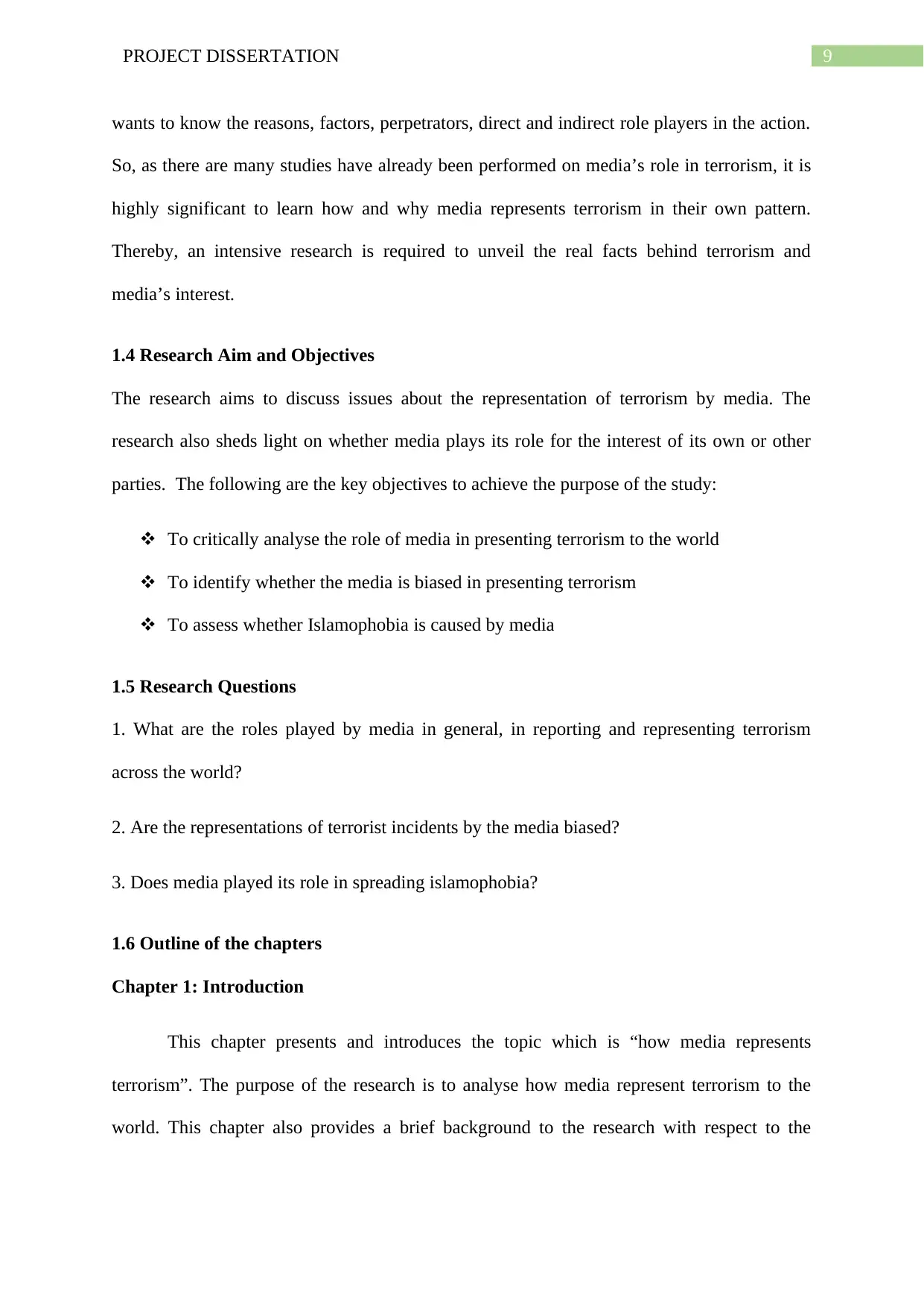
9PROJECT DISSERTATION
wants to know the reasons, factors, perpetrators, direct and indirect role players in the action.
So, as there are many studies have already been performed on media’s role in terrorism, it is
highly significant to learn how and why media represents terrorism in their own pattern.
Thereby, an intensive research is required to unveil the real facts behind terrorism and
media’s interest.
1.4 Research Aim and Objectives
The research aims to discuss issues about the representation of terrorism by media. The
research also sheds light on whether media plays its role for the interest of its own or other
parties. The following are the key objectives to achieve the purpose of the study:
To critically analyse the role of media in presenting terrorism to the world
To identify whether the media is biased in presenting terrorism
To assess whether Islamophobia is caused by media
1.5 Research Questions
1. What are the roles played by media in general, in reporting and representing terrorism
across the world?
2. Are the representations of terrorist incidents by the media biased?
3. Does media played its role in spreading islamophobia?
1.6 Outline of the chapters
Chapter 1: Introduction
This chapter presents and introduces the topic which is “how media represents
terrorism”. The purpose of the research is to analyse how media represent terrorism to the
world. This chapter also provides a brief background to the research with respect to the
wants to know the reasons, factors, perpetrators, direct and indirect role players in the action.
So, as there are many studies have already been performed on media’s role in terrorism, it is
highly significant to learn how and why media represents terrorism in their own pattern.
Thereby, an intensive research is required to unveil the real facts behind terrorism and
media’s interest.
1.4 Research Aim and Objectives
The research aims to discuss issues about the representation of terrorism by media. The
research also sheds light on whether media plays its role for the interest of its own or other
parties. The following are the key objectives to achieve the purpose of the study:
To critically analyse the role of media in presenting terrorism to the world
To identify whether the media is biased in presenting terrorism
To assess whether Islamophobia is caused by media
1.5 Research Questions
1. What are the roles played by media in general, in reporting and representing terrorism
across the world?
2. Are the representations of terrorist incidents by the media biased?
3. Does media played its role in spreading islamophobia?
1.6 Outline of the chapters
Chapter 1: Introduction
This chapter presents and introduces the topic which is “how media represents
terrorism”. The purpose of the research is to analyse how media represent terrorism to the
world. This chapter also provides a brief background to the research with respect to the
⊘ This is a preview!⊘
Do you want full access?
Subscribe today to unlock all pages.

Trusted by 1+ million students worldwide
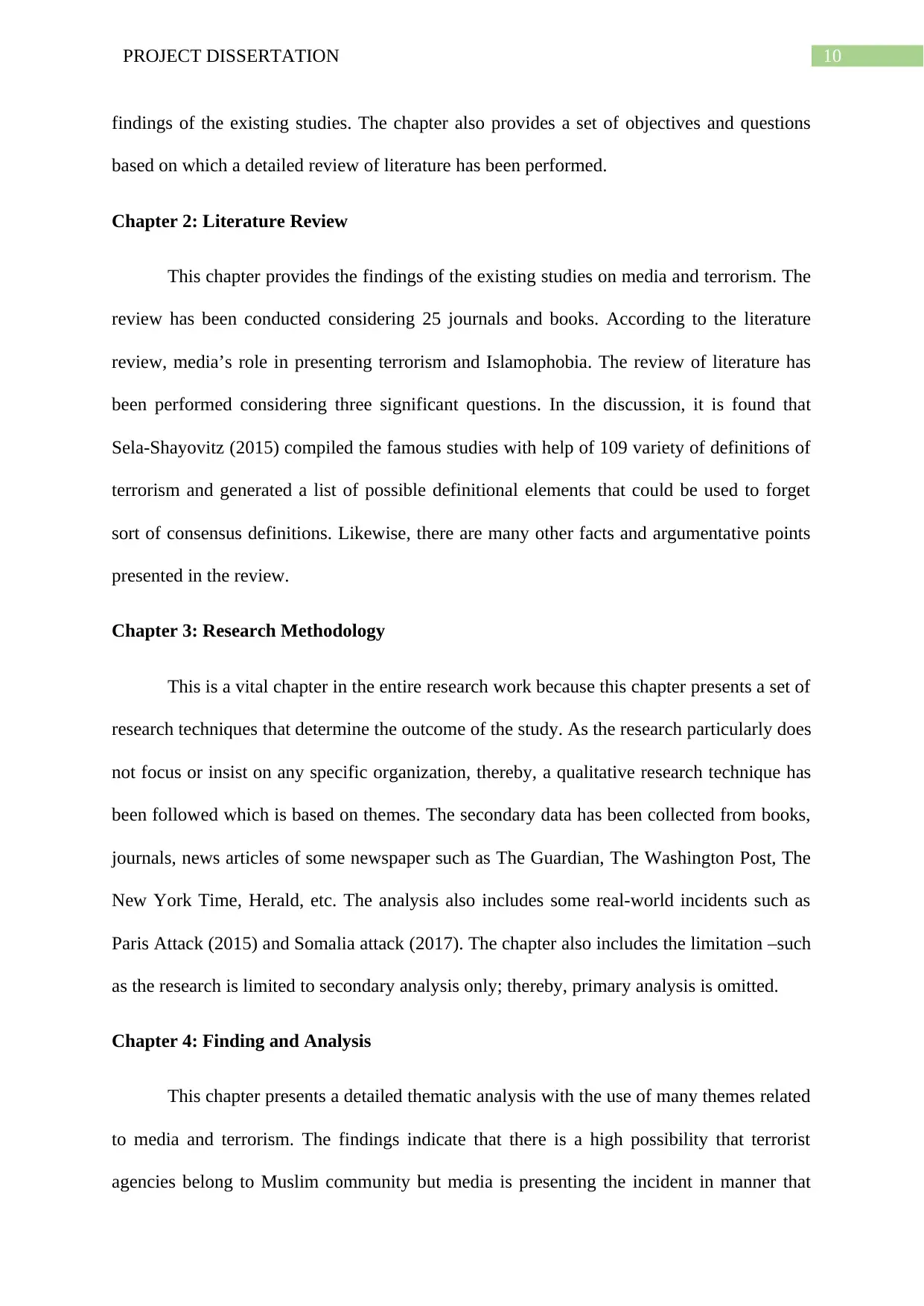
10PROJECT DISSERTATION
findings of the existing studies. The chapter also provides a set of objectives and questions
based on which a detailed review of literature has been performed.
Chapter 2: Literature Review
This chapter provides the findings of the existing studies on media and terrorism. The
review has been conducted considering 25 journals and books. According to the literature
review, media’s role in presenting terrorism and Islamophobia. The review of literature has
been performed considering three significant questions. In the discussion, it is found that
Sela-Shayovitz (2015) compiled the famous studies with help of 109 variety of definitions of
terrorism and generated a list of possible definitional elements that could be used to forget
sort of consensus definitions. Likewise, there are many other facts and argumentative points
presented in the review.
Chapter 3: Research Methodology
This is a vital chapter in the entire research work because this chapter presents a set of
research techniques that determine the outcome of the study. As the research particularly does
not focus or insist on any specific organization, thereby, a qualitative research technique has
been followed which is based on themes. The secondary data has been collected from books,
journals, news articles of some newspaper such as The Guardian, The Washington Post, The
New York Time, Herald, etc. The analysis also includes some real-world incidents such as
Paris Attack (2015) and Somalia attack (2017). The chapter also includes the limitation –such
as the research is limited to secondary analysis only; thereby, primary analysis is omitted.
Chapter 4: Finding and Analysis
This chapter presents a detailed thematic analysis with the use of many themes related
to media and terrorism. The findings indicate that there is a high possibility that terrorist
agencies belong to Muslim community but media is presenting the incident in manner that
findings of the existing studies. The chapter also provides a set of objectives and questions
based on which a detailed review of literature has been performed.
Chapter 2: Literature Review
This chapter provides the findings of the existing studies on media and terrorism. The
review has been conducted considering 25 journals and books. According to the literature
review, media’s role in presenting terrorism and Islamophobia. The review of literature has
been performed considering three significant questions. In the discussion, it is found that
Sela-Shayovitz (2015) compiled the famous studies with help of 109 variety of definitions of
terrorism and generated a list of possible definitional elements that could be used to forget
sort of consensus definitions. Likewise, there are many other facts and argumentative points
presented in the review.
Chapter 3: Research Methodology
This is a vital chapter in the entire research work because this chapter presents a set of
research techniques that determine the outcome of the study. As the research particularly does
not focus or insist on any specific organization, thereby, a qualitative research technique has
been followed which is based on themes. The secondary data has been collected from books,
journals, news articles of some newspaper such as The Guardian, The Washington Post, The
New York Time, Herald, etc. The analysis also includes some real-world incidents such as
Paris Attack (2015) and Somalia attack (2017). The chapter also includes the limitation –such
as the research is limited to secondary analysis only; thereby, primary analysis is omitted.
Chapter 4: Finding and Analysis
This chapter presents a detailed thematic analysis with the use of many themes related
to media and terrorism. The findings indicate that there is a high possibility that terrorist
agencies belong to Muslim community but media is presenting the incident in manner that
Paraphrase This Document
Need a fresh take? Get an instant paraphrase of this document with our AI Paraphraser
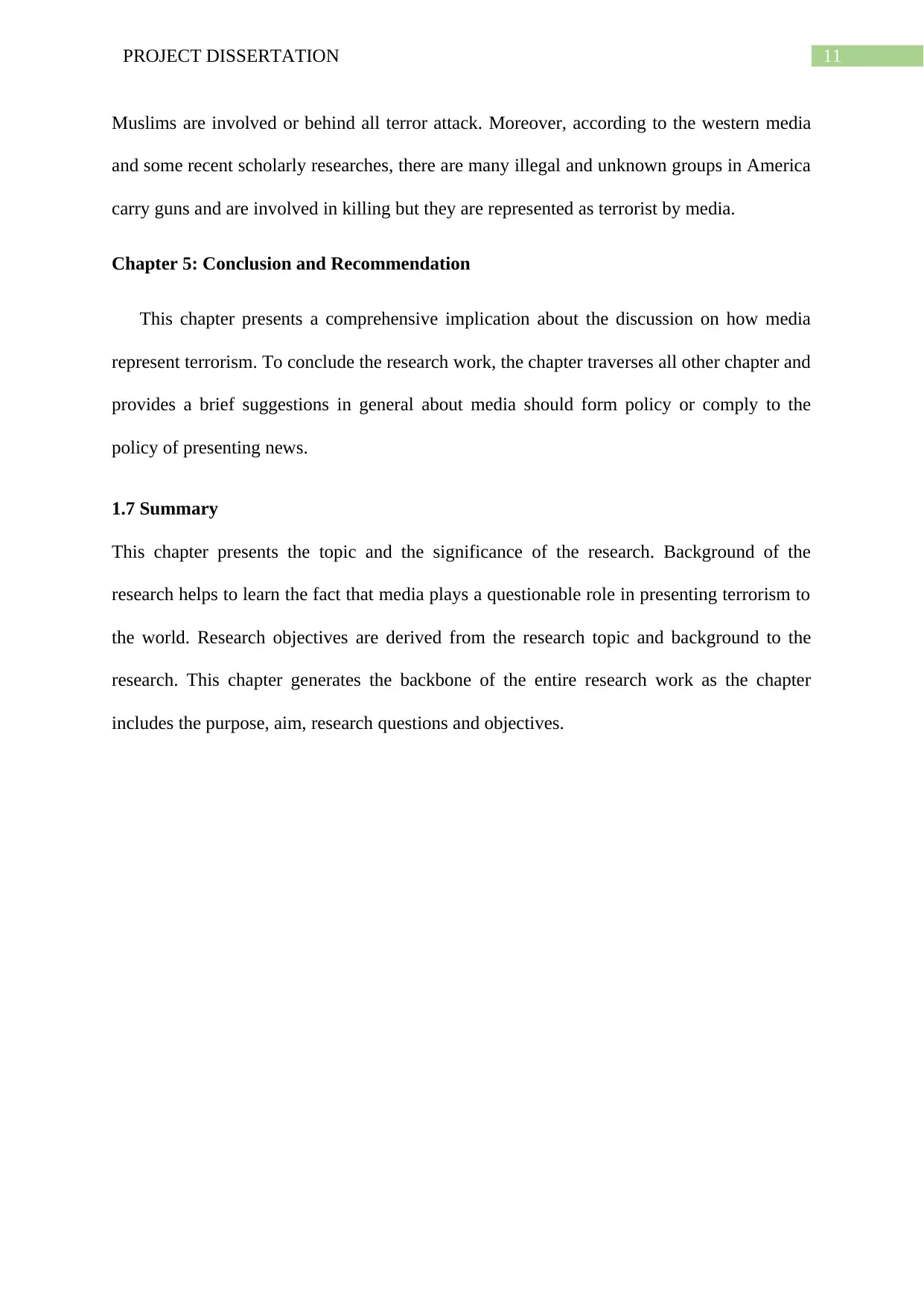
11PROJECT DISSERTATION
Muslims are involved or behind all terror attack. Moreover, according to the western media
and some recent scholarly researches, there are many illegal and unknown groups in America
carry guns and are involved in killing but they are represented as terrorist by media.
Chapter 5: Conclusion and Recommendation
This chapter presents a comprehensive implication about the discussion on how media
represent terrorism. To conclude the research work, the chapter traverses all other chapter and
provides a brief suggestions in general about media should form policy or comply to the
policy of presenting news.
1.7 Summary
This chapter presents the topic and the significance of the research. Background of the
research helps to learn the fact that media plays a questionable role in presenting terrorism to
the world. Research objectives are derived from the research topic and background to the
research. This chapter generates the backbone of the entire research work as the chapter
includes the purpose, aim, research questions and objectives.
Muslims are involved or behind all terror attack. Moreover, according to the western media
and some recent scholarly researches, there are many illegal and unknown groups in America
carry guns and are involved in killing but they are represented as terrorist by media.
Chapter 5: Conclusion and Recommendation
This chapter presents a comprehensive implication about the discussion on how media
represent terrorism. To conclude the research work, the chapter traverses all other chapter and
provides a brief suggestions in general about media should form policy or comply to the
policy of presenting news.
1.7 Summary
This chapter presents the topic and the significance of the research. Background of the
research helps to learn the fact that media plays a questionable role in presenting terrorism to
the world. Research objectives are derived from the research topic and background to the
research. This chapter generates the backbone of the entire research work as the chapter
includes the purpose, aim, research questions and objectives.
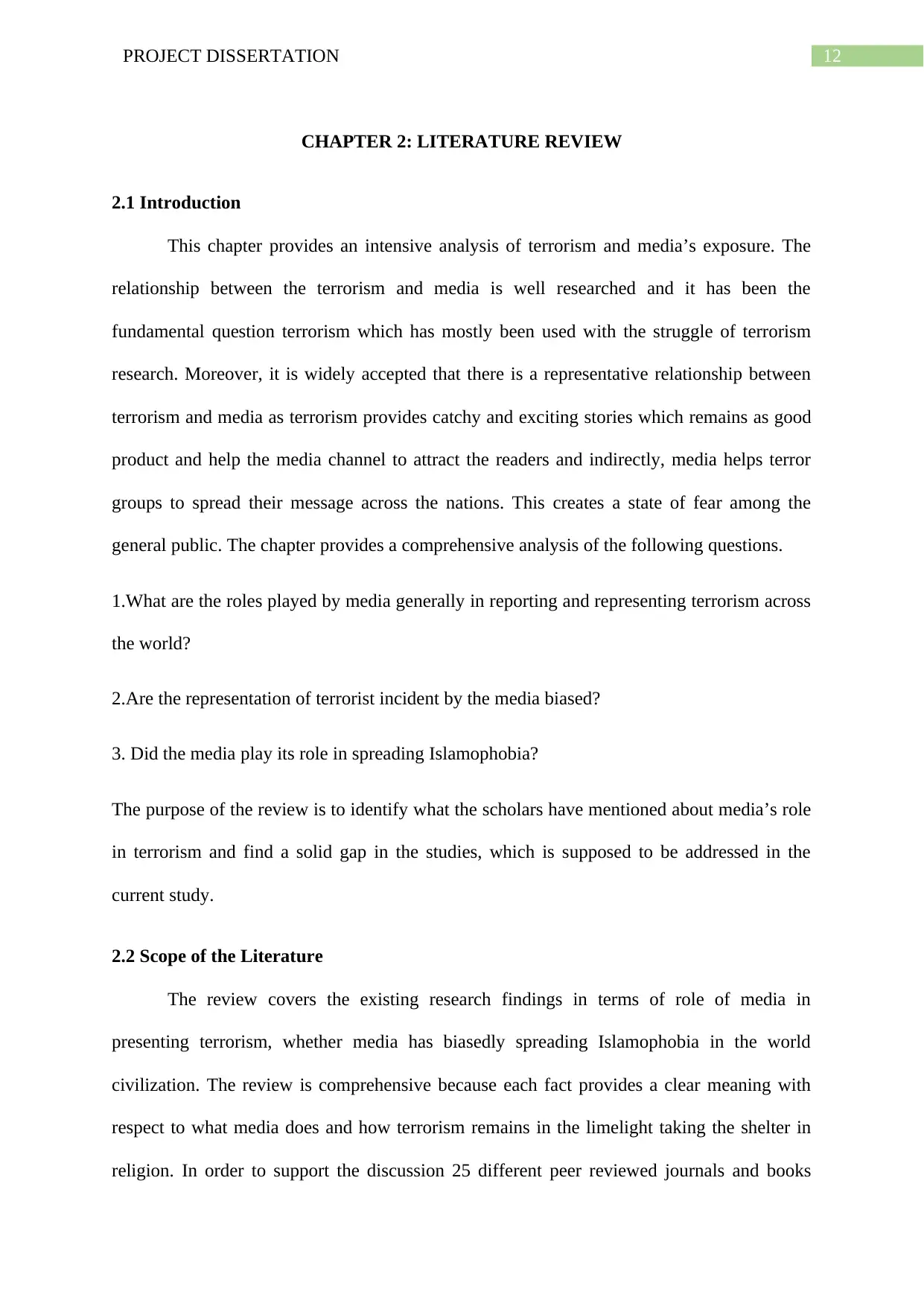
12PROJECT DISSERTATION
CHAPTER 2: LITERATURE REVIEW
2.1 Introduction
This chapter provides an intensive analysis of terrorism and media’s exposure. The
relationship between the terrorism and media is well researched and it has been the
fundamental question terrorism which has mostly been used with the struggle of terrorism
research. Moreover, it is widely accepted that there is a representative relationship between
terrorism and media as terrorism provides catchy and exciting stories which remains as good
product and help the media channel to attract the readers and indirectly, media helps terror
groups to spread their message across the nations. This creates a state of fear among the
general public. The chapter provides a comprehensive analysis of the following questions.
1.What are the roles played by media generally in reporting and representing terrorism across
the world?
2.Are the representation of terrorist incident by the media biased?
3. Did the media play its role in spreading Islamophobia?
The purpose of the review is to identify what the scholars have mentioned about media’s role
in terrorism and find a solid gap in the studies, which is supposed to be addressed in the
current study.
2.2 Scope of the Literature
The review covers the existing research findings in terms of role of media in
presenting terrorism, whether media has biasedly spreading Islamophobia in the world
civilization. The review is comprehensive because each fact provides a clear meaning with
respect to what media does and how terrorism remains in the limelight taking the shelter in
religion. In order to support the discussion 25 different peer reviewed journals and books
CHAPTER 2: LITERATURE REVIEW
2.1 Introduction
This chapter provides an intensive analysis of terrorism and media’s exposure. The
relationship between the terrorism and media is well researched and it has been the
fundamental question terrorism which has mostly been used with the struggle of terrorism
research. Moreover, it is widely accepted that there is a representative relationship between
terrorism and media as terrorism provides catchy and exciting stories which remains as good
product and help the media channel to attract the readers and indirectly, media helps terror
groups to spread their message across the nations. This creates a state of fear among the
general public. The chapter provides a comprehensive analysis of the following questions.
1.What are the roles played by media generally in reporting and representing terrorism across
the world?
2.Are the representation of terrorist incident by the media biased?
3. Did the media play its role in spreading Islamophobia?
The purpose of the review is to identify what the scholars have mentioned about media’s role
in terrorism and find a solid gap in the studies, which is supposed to be addressed in the
current study.
2.2 Scope of the Literature
The review covers the existing research findings in terms of role of media in
presenting terrorism, whether media has biasedly spreading Islamophobia in the world
civilization. The review is comprehensive because each fact provides a clear meaning with
respect to what media does and how terrorism remains in the limelight taking the shelter in
religion. In order to support the discussion 25 different peer reviewed journals and books
⊘ This is a preview!⊘
Do you want full access?
Subscribe today to unlock all pages.

Trusted by 1+ million students worldwide
1 out of 74
Related Documents
Your All-in-One AI-Powered Toolkit for Academic Success.
+13062052269
info@desklib.com
Available 24*7 on WhatsApp / Email
![[object Object]](/_next/static/media/star-bottom.7253800d.svg)
Unlock your academic potential
Copyright © 2020–2025 A2Z Services. All Rights Reserved. Developed and managed by ZUCOL.





